Like all major scales, the D major scale has 7 notes, which means that there are 7 chords in the key of D. Each chord will root on a note of the scale.
Popular chord progressions in the key of D
| Progression | Chords |
|---|---|
| I-IV-V | D-G-A |
| I-IV-I-V | D-G-D-A |
| I-V-vi-IV | D-A-Bm-G |
| I-ii-IV-V | D-Em-G-A |
| I-vi-ii-V | D-Bm-Em-A |
| I-vi-IV-V | D-Bm-G-A |
Why are these the chords in the key of D major? (the theory)
The chords in D will root on the notes along the D major scale, since all chords in a major key are formed by notes from their respective diatonic scale. We're going to head into music theory land now, so if you need to, brush up on your knowledge of the major scale.
So as I was saying, the D major scale has 7 notes, here they are with the corresponding scale degree:
Degree: 1 2 3 4 5 6 7 1(octave)
Note: D E F# G A B C# D
But how do we know which chord will be major or minor?
Starting from a given root note, we need to form its triad in a way that leaves the chord constructed only from notes that can be found on the D major scale.
This means that starting from each root note, we’ll count out the 1st , 3rd , and 5th degrees along the major scale of that given root note. We then compare these notes with the notes of the D major, and if any single note is not in our key, we’ll have to flatten it to make it a note that can be found on the D major scale.
We'll get to some examples shortly, don't worry
So we’ll be differentiating 3 triads:
- Major triad (major chords) with scale degrees 1 3 5
- Minor triad (minor chords) with scale degrees 1 b3 5
- Diminished triads (diminished chords) with scale degrees 1 b3 b5
Now let’s calculate the quality of each chord in the key of D.
D major
Note: D E F# G A B C# D
Triad: 1 3 5
This gives us the notes D, F# and A, which is the D major triad, therefore the first chord in the key of D is D major.E minor
Note: E F# G# A B C# D# E
Triad: 1 3 5
So our 3rd note for would be a G#, but we can’t have that, since that note is not in the key of D major (not on the D major scale). We have to lower the 3rd to the flattened 3rd.
Note: E F# G A B C# D# E
Triad: 1 b3 5
This gives us the notes E, G and B, which is the E minor triad. All of these notes are on the D major scale as well, therefore the second chord in the key of D is E minor.F# minor
Note: F# G# A# B C# D# E# F#
Triad: 1 3 5
So our 3rd note would be an A#, but we can’t have that, since that note is not in the key of D. We have to lower the 3rd to the flattened 3rd.
Note: F# G# A B C# D# E# F#
Triad: 1 b3 5
This gives us the notes F#, A and C#, which is the F# minor triad, therefore the third chord in the key of D is F# minor.G major
Note: G A B C D E F# G
Triad: 1 3 5
This time we’re in luck, the 1st, 3rd and 5th of the G major scale are in the key of D, so we don’t need to modify any of the notes. We get the notes G, B and D, which is the G major triad, therefore the fourth chord in the key of D is G major.A major
Note: A B C# D E F# G# A
Triad: 1 3 5
Again, the 1st, 3rd and 5th of the A major scale are in the key of D, so we don’t need to modify any of the notes. We get the notes A, C# and E, which is the A major triad, therefore the fifth chord in the key of D is A major.B minor
Note: B C# D# E F# G# A# B
Triad: 1 3 5
Again, we need to modify our 3rd note, which would be a D#, since that note is not in the key of D. We have to lower the 3rd to the flattened 3rd.
Note: B C# D E F# G# A# B
Triad: 1 b3 5
This gives us the notes B, D and F#, which is the B minor triad, therefore the sixth chord in the key of D is B minor.C# diminished
Note: C# D# E# F# G# A# B# C#
Triad: 1 3 5
Ohoh, now we need to flatten the 3rd AND the 5th, since neither the X or the X are on the D major scale.
Note: C# D# E F# G A# B# C#
Triad: 1 b3 b5
This gives us the notes C#, E and G, which is the C# diminished triad, therefore the seventh chord in the key of D is C# diminished.
And there you have it ladies and gentleman, the chords in the key of D. You should now know not just each chord, but also why each chord is major or minor.
Have a look at guitar chords in other keys as well.

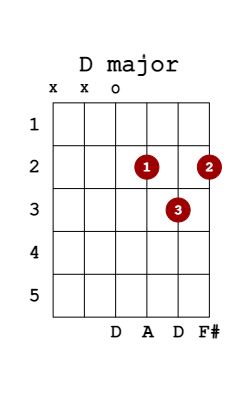

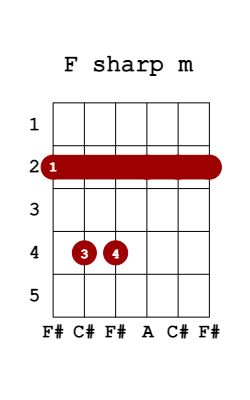
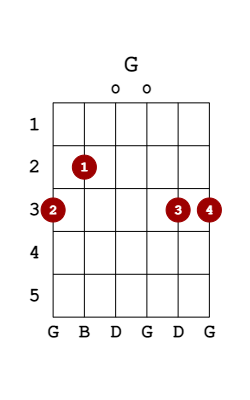

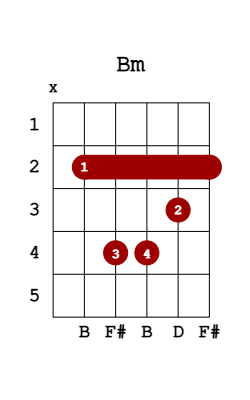
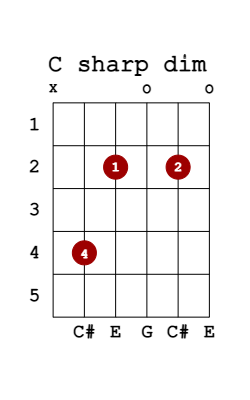

This helped me a lot, not just for chords in the key of Dmaj (my initial interest) but in learning music theory generally. It’s a cliché – but still true – that stuff makes more sense when you have a pressing need to learn it so you can use it. Thank you.
I am trying to understand why Asus4/G sounds like it is in the key D.(played in progression with A major). And why this sus4 note (D) has powerful qualities from a theory standpoint.
Hi Ken, an Asus4 has the same notes as a Dsus2 (E, A, and D), it is an inversion.
thank you very much
this article really helped me in understanding music theory
Cheers to everyone who contributed to this article